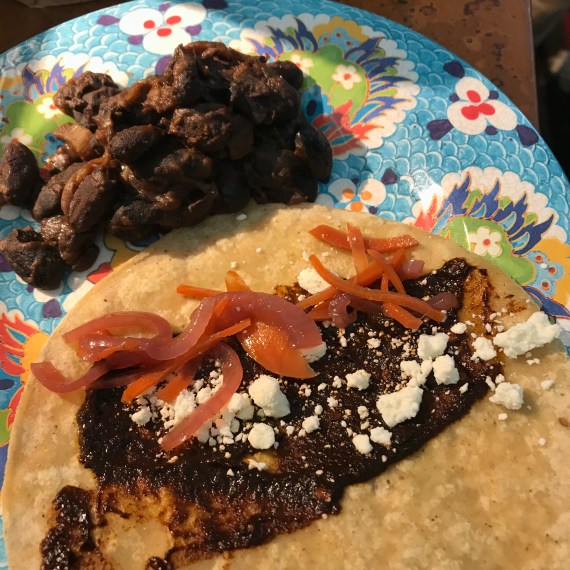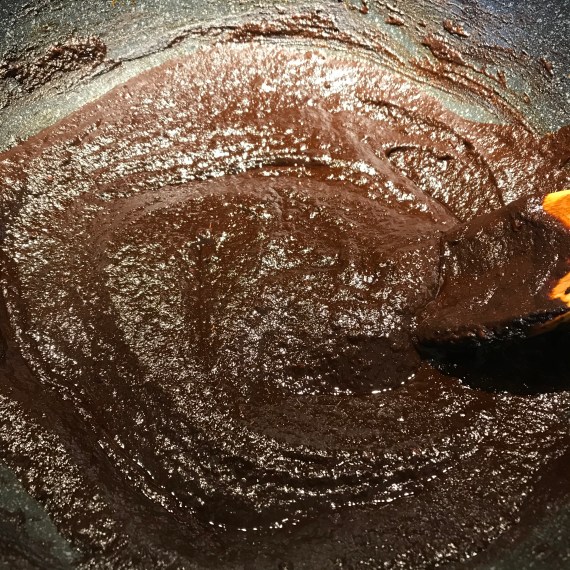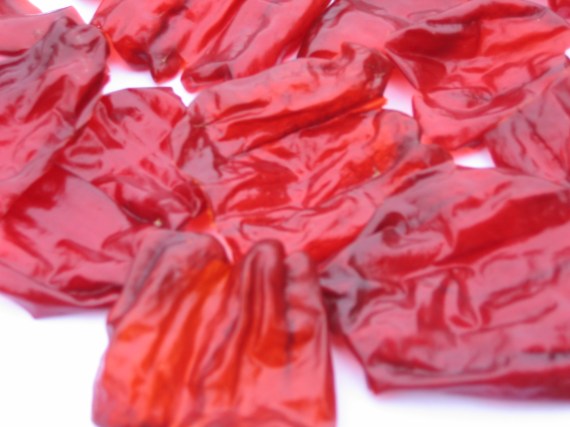
In the past, when I traveled in Oaxaca, I fell in love with the moles, as nearly every traveler there does. My favorite is the rich, complex, highly seasoned mole negro, and I have made the mole paste for it a few times but find that I seldom have enough uninterrupted time to collect all the ingredients, prepare and fry them individually, grind them together, etc. There are a few good commercial brands of mole negro paste, and on the rare occasions when I want this special dish, I tend to use them.
But I often crave flavors that are somewhat reminiscent of mole negro, involving deep, rich, earthy tones with a spicy seasoned overlay and an element of slow, dark fire. For those occasions, I have come up with a seasoning paste that I can make in the winter, keep in my refrigerator, and add where appropriate. Properly speaking it’s a salsa, but in the American minds salsa is the fresher lighter tomato concoction, so I call it a sauce. The ingredient list is simple, although if you live in an area that lacks a substantial Mexican population you may need to order the chiles by mail. The prep may seem time-consuming, but comfort yourself that it’s insignificant compared to the time spent making mole negro. You’ll need a blender.
7 chiles Pasilla Negro, often just sold as chiles negros
7 chiles chipotle meco (medium-sized and light brown, not small and dark red)
1 7 ounce can chipotles in adobo, including all the liquid
8 cloves garlic, not peeled
1/2 cup raisins
3 cups chicken broth
1/2 teaspoon Ceylon (canela) cinnamon or a bit less standard cinnamon
1/4 teaspoon freshly ground allspice
2 tablespoons grated piloncillo or coconut sugar
1/2 teaspoon salt, oak-smoked if available.
2 cups avocado oil for frying
1/4 cup homemade lard or more avocado oil for searing the sauce
Cut the stem ends off all the dry chiles, cut them open down one side with kitchen scissors, and scrape out most of the seeds and veins. Snip each one across the length a couple of times. In a small deep sauce pan, heat the avocado oil intended for frying to about 350 or until a piece of chili put into the oil immediately bubbles and sizzles. Have paper towels ready for draining. Put a small handful of the chiles into the oil at a time, fry them until the color changes visibly turning as needed, fish them out with a slotted spoon, and drain them. Now put the cloves of garlic, still in their skins, in the oil and let them fry until the skins are somewhat browned, and drain them. Put the raisins in the hot oil and fry just until they swell and puff, then drain. Now set the saucepan of oil aside in a very safe place to cool off.
Heat the chicken broth to boiling in another pot, turn off the heat, and put all the fried chiles in the hot broth to soak for 20 minutes. Peel the garlic cloves and add them.
Put the soaked chiles and peeled garlic cloves and their fluid in the blender jar along with the seasonings, the sugar, and the canned chipotles with all their adobo fluid. Grind smooth, scraping down the blender as needed. Add a little more water if needed to keep the blender blades turning.
Now for the dramatic step that pulls the sauce together. In a large frying vessel (I prefer a wok to minimize the inevitable splattering,) heat the lard or avocado oil over high heat. When it’s very hot, pour in the purée from the blender jar. Use an apron and don’t lean over the stove, because it will sizzle and splatter viciously. Stir cautiously with a wooden spoon. After 3-4 minutes turn the heat down to simmer and simmer the sauce for about 30 minutes, stirring occasionally.
When ready, the sauce is very thick and will hold indentations when stirred, but it’s not cooked down to a paste. Taste it and adjust the salt if needed, but in my opinion use table salt and not smoked salt at this point. If it tastes a little bit on the acrid side, you may need to add a little more dark sugar.
Now you’re done and can quickly and efficiently add notes of earth and fire wherever you think they are needed. Use diluted or undiluted. The finished sauce can be spread directly on hamburgers immediately after grilling. A tablespoon or two per serving of black beans adds immeasurably to their meaty richness, and this combination is especially good with a dollop of crème fraîche on top. A few tablespoons per cup of chicken or turkey broth makes a wonderful sauce for roasted or smoked birds. It could be used as a rub for grilled chicken, although you need to be careful not to burn it. I think that it might make a good grilling rub for salmon or other strong-flavored fish. It adds wonderful depth to sautéed mushrooms, and I think it would be great on grilled carrots or roasted sweet potatoes, especially with a pat of butter on top. For a quick snack or lunch, nothing beats a quickly griddled tortilla with a smear of Earth and Fire sauce, a sprinkle of crumbled cotija cheese, and a few quick-pickled vegetables. A quick soft taco also makes a great cook’s treat. If you’re hungrier than that, add some frijoles negros or frijoles refritos as shown at the top of this post. A good dollop in a bowl of good posole elevates it to a feast.

It can be frozen after preparation for use later, either in jars or in individual portions in large ice cube trays. On late afternoons when you need something warm and not too filling, a cube could be dropped in a cup of hot chicken broth to make a warming “instant” soup.
A few notes on ingredients:
The best chiles that I know of come from The Chile Guy
The best beans and posole corn that I know of come from Rancho Gordo
The only lard worth using is the lard that you render yourself, not the awful commercial stuff. If you don’t want to render a little, use oil instead.
My favorite tortillas are the nixtamalized heirloom corn tortillas from Masienda. In my area, Whole Foods carries them.



